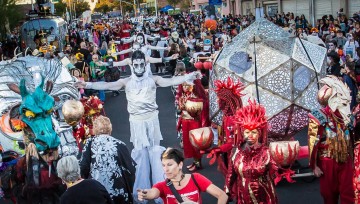
We get this question a lot. And there are a lot of misconceptions embedded in it. Clearing up those misconceptions can help you have a much more meaningful All Souls Procession experience.
Parade vs. Procession
Let’s start with the easy one: Parade. The All Souls Procession is not a parade as parade is commonly defined. Usually, when you think of a parade it’s a bunch of pre-registered, fee-paying floats and groups that walk down the middle of the road while everyone else stands on the sidelines and watches.
The Procession is pretty much the exact opposite of that! It’s a full-participation, attendee-created event. Everyone is welcome in the streets. In fact, part of the point is to get into the street—to process for the dead you are remembering. It’s about participation, about creating your own meaningful experience by becoming part of the event—whether that means walking, setting up an altar on the side of the road, or holding a photograph of a loved one as you watch the Procession go by.
Day of the Dead?
Now for the Day of the Dead part of the question. A lot of people assume that because the Procession is about honoring the dead and takes place close to Mexico, the Procession is a Dia de los Muertos/Day of the Dead event. It isn’t.
The Procession is about honoring and celebrating the dead in whatever creative, authentic way you want to. As a result, it is open to all traditions—Aztec, Japanese, Irish, Iraqi, Somali, Tohono O’odham, or any other cultural tradition. And it is open to new traditions, to freshly created ways of honoring the dead and grieving our other losses—losses of ideas, of hopes, of dreams, of homes, of relationships.
At the heart of the Procession is a belief in the power of simple creative acts to help people grieve. The Procession’s origins are in Tucson’s arts community, and we offer arts and dance and other workshops all Fall to help everyone join in on those creative traditions. (Check out our calendar for listings.) Just as the Procession is open to all cultures, it is open to and encourages all art forms. Whether you create a big head puppet, spin fire in the Finale, create a costume with a deeply personal meaning, play an instrument, decorate a loved one’s photograph with flowers, or simply place a message in the Urn for burning, your participation is what creates the Procession.
If Dia de los Muertos is your cultural tradition for honoring the dead, by all means bring it to the Procession! But if you come expecting the All Souls Procession to be a Dia de los Muertos event, you will probably be disappointed. The same if Obon is your tradition. Or New Orleans jazz funerals.
You don’t have to wear sugar skull makeup or a Catrina costume to do All Souls Procession “right.” There is no right way to mourn and celebrate your dead. There is only the way that is meaningful and authentic to you. That might mean digging into your own ancestry for traditions you can reclaim and repurpose for the Procession. Or it might mean adopting some of the Procession’s creative traditions. Or perhaps creating an entirely new remembrance of your own. All are welcome.
When?
Oh—and to answer the other part of the question, check the calendar for the current All Souls Procession event listings! Procession weekend is typically the first weekend after All Souls Day/Dia de los Muertos/Day of the Dead. So the first weekend after November 2, which in 2015 means November 7 (Procession of Little Angels) and November 8 (All Souls Procession).